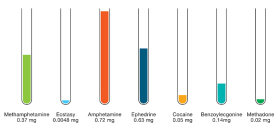
« PREVIOUS ENTRY
The appendix mystery, solved: My Times Year in Ideas piece
NEXT ENTRY »
The death of checkers: My Times Year in Ideas piece

A couple of weeks ago, the New York Times Magazine published its 2007 “Year in Ideas” issue — their annual compendium of the year’s most interesting and offbeat research. I wrote up five of their scientific and technological entries. The entire issue is online here for free, but I’m also archiving my pieces here for posterity’s sake.
This one’s about “community urinanalysis”! The illustration, by Cybu Richli, accompanied it.
Community Urinalysis
Everyone knows how a drug test works: You urinate into a cup and your employer (or prospective employer) has the sample tested to see if you’ve been using any illegal substances. This year, though, Jennifer Field, an environmental chemist at Oregon State University, experimented with an unusual variation on this process. She found out what illicit drugs the population of an entire city was ingesting.
How? By collecting and then testing water from the city’s sewage-treatment plant. Since all drug users urinate, and since the urine eventually winds up in the sewers, Field and her fellow researchers figured that sewer water would contain traces of whatever drugs the citizens were using.
Sure enough, when Field’s team tested a mere teaspoonful of water from a sewage plant — which it ultimately did in many American cities — the sample revealed the presence of 11 different drugs, including cocaine and methamphetamine.
The research team called this technique community urinalysis. From a privacy standpoint, it’s a very clever approach to monitoring drug usage, because while it is involuntary — drug users can’t help urinating — it also manages to preserve the public’s anonymity. “It’s the closest to the urinal you can get without violating privacy,” says Field, who presented her findings at an August meeting of the American Chemical Society.
Because it allows for sampling on a daily basis, community urinalysis can track a drug epidemic in real time, showing the police and doctors how the popularity of a particular drug is waxing or waning. For instance, Field says that the use of methamphetamine was constant from day to day — because “once you’re hooked, you’re hooked” — whereas the usage of cocaine sometimes peaked on weekends.
One affluent community that Field tested showed very few drugs except cocaine; by contrast, methamphetamine levels varied widely from city to city. And the single most popular drug? Caffeine. CLIVE THOMPSON
I'm Clive Thompson, the author of Smarter Than You Think: How Technology is Changing Our Minds for the Better (Penguin Press). You can order the book now at Amazon, Barnes and Noble, Powells, Indiebound, or through your local bookstore! I'm also a contributing writer for the New York Times Magazine and a columnist for Wired magazine. Email is here or ping me via the antiquated form of AOL IM (pomeranian99).

ECHO
Erik Weissengruber
Vespaboy
Terri Senft
Tom Igoe
El Rey Del Art
Morgan Noel
Maura Johnston
Cori Eckert
Heather Gold
Andrew Hearst
Chris Allbritton
Bret Dawson
Michele Tepper
Sharyn November
Gail Jaitin
Barnaby Marshall
Frankly, I'd Rather Not
The Shifted Librarian
Ryan Bigge
Nick Denton
Howard Sherman's Nuggets
Serial Deviant
Ellen McDermott
Jeff Liu
Marc Kelsey
Chris Shieh
Iron Monkey
Diversions
Rob Toole
Donut Rock City
Ross Judson
Idle Words
J-Walk Blog
The Antic Muse
Tribblescape
Little Things
Jeff Heer
Abstract Dynamics
Snark Market
Plastic Bag
Sensory Impact
Incoming Signals
MemeFirst
MemoryCard
Majikthise
Ludonauts
Boing Boing
Slashdot
Atrios
Smart Mobs
Plastic
Ludology.org
The Feature
Gizmodo
game girl
Mindjack
Techdirt Wireless News
Corante Gaming blog
Corante Social Software blog
ECHO
SciTech Daily
Arts and Letters Daily
Textually.org
BlogPulse
Robots.net
Alan Reiter's Wireless Data Weblog
Brad DeLong
Viral Marketing Blog
Gameblogs
Slashdot Games